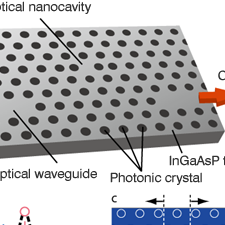World's lowest energy consumption by an optical switch, into the atto-Joule region.
- Step toward the introduction of optical network technology for microprocessor chips -

NTT Basic Research Laboratories and NTT Photonics Laboratories have succeeded in the ultralow energy operation of an optical switch whose energy consumption is in the atto-Joule region.
The switch was manufactured by using an artificial periodic structure, called a photonic crystal, which can confine light in an ultrasmall region. The energy consumption is less than 1/200 that of the previous record. Previous optical switches exhibit a trade-off between high-speed operation and low energy consumption, and it has been difficult to balance low energy and fast switching. The size of the newly developed optical switch has been greatly reduced by employing an ultrasmall optical nanocavity made of photonic crystal.
A reduction in switching energy has been achieved by (1) introducing InGaAsP with high-energy efficiency, and (2) constructing the optical switch by using an ultrasmall photonic crystal nanocavity as an optical cavity structure. As a result, we have achieved a switching operation that realizes a 1/2 extinction ratio in 20-40 psec using an optical control pulse with an energy of 420 aJ. Similarly, an optical control pulse with 660 aJ energy yields a larger extinction ratio of 1/10. Furthermore, we realized an optical switch operation that selects a specific bit from a continuous 40 Gbit/sec pulse sequence.
This achievement will be published in the online express edition of the UK science magazine "Nature Photonics" on May 2.
=> Photonic Nano-Structure Research Group

Fig. 1 Schematic diagram of an optical switch that employs a photonic crystal nanocavity
Newly developed ultrasmall optical switch using photonic crystal (top), operating principle (bottom left), and spatial distribution of light intensity (bottom right). The refractive index of the cavity changes only the control light is being input, and the resonant frequency is shifted. Consequently the signal light is intercepted and switch operation is observed.

Fig. 2 Observed switching operation of the developed device.
The figure shows the temporal change in the transmitted output light intensity of the signal light. It can be confirmed that the signal light is switched quickly by the control light. The figure reveals that the decrease in the signal light occurs only while the control light is being input.










